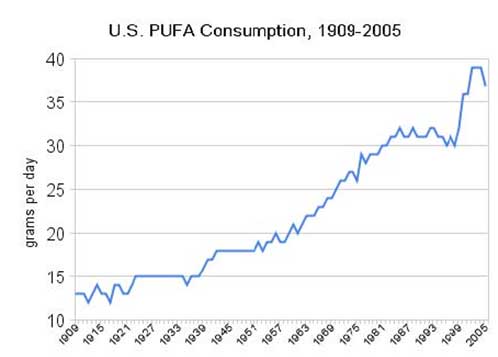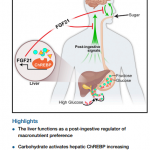The Science is Practically Screaming… Don’t Make This Trendy Fat Mistake
By Dr. Mercola
The science is loud and clear: the correct balance of fatty acids is essential if you want to be the healthiest you can be.
There are actually two problems related to how these fats are being consumed by most Westerners today:
- Most people are consuming far too many omega-6 fats compared to omega-3 fats.
The ideal ratio of omega-3 to omega-6 fats is 1:1, but the typical Western diet is between 1:20 and 1:50.
- The typical Westerner is consuming far too many polyunsaturated fats (PUFAs) altogether, which is a problem in and of itself.
So, most consume the wrong amount—AND the wrong ratio of these highly benefical fats.
Both omega-3 and omega-6 fats are PUFAs and they’re both essential to your health, but when omega-6 is consumed in excess, it become problematic.
As a group, when consumed in the wrong ratios, they tend to stimulate inflammatory processes in your body, rather than inhibit them.
You need some inflammation to protect yourself from infections and trauma, and PUFAs help you mount these defenses.
However, too many PUFAs contribute to chronic inflammation, which causes all sorts of problems over the long-term. Inflammation is at the source of just about every chronic disease we see today. Consumption of polyunsaturated fat in the U.S. has gone from about 13 grams per day to nearly 40 grams per day over the past century (see figure below).
Increase in American PUFA Consumption
From Stephan Guyenet’s Whole Health Source BlogBy far, the type of omega fats that most Westerners get too much of is the omega-6 variety, due to its prevalence in processed foods—and this is what’s driving up the line on the graph. It is easy to get confused when reading about the different types of fats—there are saturated fats and unsaturated fats, omega-3s and omega-6s, PUFAs, long-chain and short-chain fats, and the list goes on.
In order to help clear up the confusion, this article aims to provide you with a “primer” on fatty acids to increase your understanding of the fundamental differences between the types of fats and how your body uses them. So let’s start by taking a look at the overall category called “fats”—what they’re made of and what they do for you. And then we’ll take a closer look at PUFAs and omega-3s.
Contents
Fats for Dummies
Fats are one member of a group of water-insoluble substances called “lipids.” Lipids are important to you because they are the primary components of your cell membranes. Other members of the lipid group include sterols, phospholipids, triglycerides, and waxes.
Fats both in foods and in your body, are simply storage units composed of fatty acids. A fat is distinguished by the specific combination of fatty acids making it up. Fatty acids have three basic purposes in your body:
- Providing energy
- Providing the building blocks for cell membranes
- Acting as raw materials that can be converted to other substances that perform special duties in your body such as hormones.
Fatty Acid Saturation and Chain Length
The properties of fats and fatty acids depend on their degree of hydrogen saturation and the length of their molecules, or “chain length.” Chemically, a fatty acid is a chain of carbon atoms with pairs of hydrogen atoms attached, with an “acid group” attached to one end of the molecule.
There are four types of fatty acids, based on how many of their carbon bondsare paired with hydrogen:
- Saturated Fats: Fully loaded with hydrogen atoms forming straight chains, and are typically solid at room temperature (for example, butter and coconut oil)
- Unsaturated Fats: These fats have lost at least one of their pairs of hydrogen atoms from their carbon chain, resulting in molecules that kink or bend at each double bond. The more hydrogen pairs that are missing, the more bent the molecules. The more bent the molecules, the more space they occupy, thereby making the fat a liquid at room temperature (oil). Unsaturated fats come in two varieties:
- Monounsaturated Fats: Missing one pair of hydrogens
- Polyunsaturated Fats (PUFAs): Missing more than one pair of hydrogens
Vegetable oils and animal fats are typically composed of a mixture of these different fatty acid types. For example, olive oil is mostly monounsaturated fat with a small amount of polyunsaturated fat. Lard is primarily equal parts saturated fat and monounsaturated fat, but contains some polyunsaturated fat as well. Most vegetable oils high in PUFA, whereas most animal fats are high in saturated and monounsaturated fats (except for palm, coconut, and olive oils). Saturated and monounsaturated fats are more easily used by your body than polyunsaturated fats.
Fats vary in the length of their carbon chains, leading to another classification scheme based on their number of carbon pairs:
- Short-chain fatty acids (SCFAs): Less than eight carbons
- Medium-chain fatty acids (MCFAs): Eight to 14 carbons
- Long-chain fatty acids (LCFAs): 16 or more carbons
- Very-long-chain fatty acids (VLCFAs): More than 22 carbons
A fatty acid’s chain length and saturation control its melting point. As chain length increases, melting point increases. Likewise, fats that are solid at room temperature (butter, coconut oil) have longer chain lengths than fats that are liquid at room temperature (fish oil, olive oil). With chain lengths being equal, unsaturated fats have lower melting points than saturated fats.
The Chemical Instability of Polyunsaturated Fats (PUFAs)
Because your tissues are made up mostly of saturated and monounsaturated fats, your body requires more of them than polyunsaturated fats (which is true of all mammals). The main dietary PUFAs are omega-3 and omega-6 fats. Although your body does need these, it needs them in relatively smallquantities.
One of the problems with PUFAs is that they are very chemically unstable, and highly susceptible to being altered and denatured by what’s around them. Think about what happens to the oils in your pantry—they are susceptible to going rancid as a result of oxidation. In your body, PUFAs undergo a similar process when exposed to the toxic byproducts of proteins and sugars—especially fructose.
This is why most fish oil supplements have such a short shelf life, and many are already oxidized before they hit the bottle. Consuming oxidized fats can do your body more harm than good.
When you eat too many PUFAs, they are increasingly incorporated into your cell membranes. Because these fats are unstable, your cells become fragile and prone to oxidation, which leads to all sorts of health problems, such as atherosclerosis. Now let’s take a look at the most common PUFAs in your diet—the omega fats.
The Omega Fats
The end of the fatty acid chain, opposite the acid end, is the “omega end.” The location of the first double bond from the omega end dictates whether a fatty acid is an omega-3, omega-6, omega-9 (oleic acid), or another member of the “omega family.” Both omega-3s and omega-6s come in both short-and long-chain varieties.
Omega-3 Fats
- Plant Based: The shorter-chain form of omega-3 is alpha-linolenic acid (ALA), the only omega-3 found in plants (except for some algae). Foods rich in ALA include flaxseed oil (53 percent), canola oil (11 percent), English walnuts (9 percent), and soybean oil (7 percent). ALA is considered essential because your body can’t make it, so you need it in your diet—or its long-chain derivatives.
- Animal Based: The longer-chain forms of omega-3 are found mostly in animals and they are eicosapentaenoic and docosahexaenoic acids (EPA and DHA) and are highly unsaturated, mainly found in fish, shellfish and krill. DHA is the primary structural component of your brain and retina, and EPA is its precursor. Your body can make some EPA and DHA from short-chain ALA, but does so inefficiently. Recent studies suggest less than one percent of ALA is converted, if you are consuming the typical Western diet. DHA is found in cod liver oil, fatty fish, and in smaller concentrations in the organs and fats of land animals.
Omega-6 Fats
- Shorter-chain: The shorter-chain form of omega-6 is linoleic acid (LA), which is the most prevalent PUFA in the Western diet, is abundant in corn oil, sunflower oil, soybean oil and canola oil.
- Longer-chain: The longer-chain form of omega-6 is arachidonic acid (AA), which is an important constituent of cell membranes and a material your body uses to make substances that combat infection, regulate inflammation, promote blood clotting, and allow your cells to communicate. AA is found in liver, egg yolks, animal meats and seafood.
Fats: Understanding the Essentials
“Essential fatty acids” (EFAs) is a term referring to the PUFAs your body needs but cannot produce (or convert from other fats), so they must be obtained from your diet.
Traditionally, only two fats were considered “essential”—ALA (an omega-3 fat) and LA (an omega-6 fat). However, we now know it’s the long-chain derivatives—arachidonic acid, DHA, and EPA—that your body needs the most. Although you have the enzymes to convert LA into these longer-chain fats (ALA, DHA and EPA), the conversion isn’t efficient enough for optimal brain growth and development. This has led to a recent rethinking of what fats to consider “essential” and recommendations for adding more long-chain fats to your diet, to better meet these biological demands.
DHA and EPA: The “Anti-Inflammatory Fats”
Scientific studies have uncovered a number of important health benefits from omega-3 fats, and it’s looking more like it’s DHA and EPA that are responsible for those benefits, rather than ALA. Science suggests that omega-3s offer the following benefits to your health:
| Healthier, stronger bones | Protecting your tissues and organs from inflammation |
| Improved mood regulation | Brain and eye development in babies |
| Reduced risk of Parkinson’s disease | Reduced risk of Alzheimer’s disease |
| Reduced risk of death from ALL causes | Relief from Dry Eye Syndrome |
| Prevention of vascular complications from type 2 diabetes | Peripheral artery disease |
| Gallstones | Preventing postpartum depression |
| Reducing symptoms of lupus erythematosus and other autoimmune diseases | Preventing premature birth |
| Multiple sclerosis | Combating cancer |
In fact, if you go to the omega-3 fat page on GreenMedInfo.com, you will see a list of scientific studies supporting the benefits of omega-3s for 254 different diseases, which is powerful proof of their broad-reaching scope. One reason omega-3s are so good for you is their anti-inflammatory properties, especially the omega-3s from animal sources. In the case of DHA, your tissues use this fatty acid it to synthesize compounds called “resolvins,” which help to reduce inflammation.
According to the Weston A. Price Foundation:
“Sufficient DHA allows the immune system to mount a robust inflammatory response against invading pathogens or damaged tissues and to bring the response quickly to an end once the task has been accomplished.
Researchers are increasingly discovering that most degenerative diseases involve an element of chronic, low-level inflammation, and the inability to “turn off” important inflammatory processes once they are no longer needed could be part of the problem. DHA deficiency may therefore be at the root of widespread declines in cognitive function, increases in mental disorders and epidemic levels of degenerative disease.”
A study in the journal Pediatrics even showed that supplementing a mother’s DHA during pregnancy and lactation improves her child’s IQ at four years of age. EPA, which accumulates in fish, is a precursor to DHA.
Just like DHA, EPA also helps to control inflammation, but this time by interfering with arachidonic acid metabolism. Arachidonic acid is the precursor to PGE2 (a prostaglandin), which is a major initiator of inflammation. You can see how DHA and EPA would work together to naturally reduce inflammation and improve inflammatory conditions like rheumatoid arthritis and asthma.
In rheumatoid arthritis, EPA/DHA supplementation has been shown to reduce joint stiffness and soreness and improve flexibility. And for asthma, a study involving fish oil supplementation for asthmatic children (along with improved diet) resulted in better airway function and reduced need for asthma medications, without side effects. The most profound benefits of EPA may lie in its implications for people at high risk for coronary artery disease. But science has shown that EPA/DHA supplementation can benefit people with other conditions as well, such as:
- EPA/DHA supplementation has helped people with ulcerative colitis.
- Several studies have shown that people with schizophrenia often have low levels of the particular EFAs necessary for normal nerve cell membrane metabolism. Early results from a few trials suggest EPA can have a positive effect on the mental status of schizophrenics.
- Epidemiological evidence suggests that populations consuming marine diets rich in EPA have a low incidence of cancer. Experimental studies, both in vitro and in vivo, further support EPA’s anti-cancer activity.







